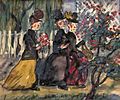
The list of women artists in the Armory Show attempts to include women artists from the United States and Europe who were exhibited in the Armory Show of 1913. The show contained approximately 1300 works by 300 artists. A high proportion of the artists were women, many of whom have since been neglected. The list is largely drawn from the catalog of the 1963 exhibition, 1913 Armory Show 50th Anniversary Exhibition organized by the Munson-Williams-Proctor Arts Institute. [1]
Contents
The Armory Show refers to the International Exhibition of Modern Art that was organized by the Association of American Painters and Sculptors and opened in New York City's 69th Regiment Armory, on Lexington Avenue between 25th and 26th Streets, on February 17, 1913, and ran to March 15. It became a legendary watershed date in the history of American art, introducing astonished New Yorkers, accustomed to realistic art, to modern art. The show served as a catalyst for American artists, who became more independent and created their own artistic language.



































